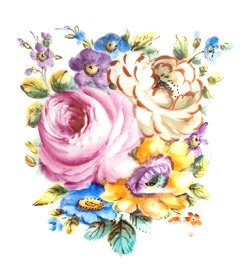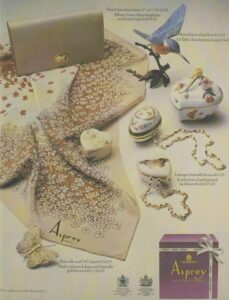It was in 1928 that Camille Le Tallec, a young graduate of the Ecole du Louvre, created his own porcelain decoration workshop in the 20th arrondissement of Paris. Very quickly, the reputation of the place grew and the entrepreneur’s collaborations with renowned brands multiplied, like his partnership with the Puitforcat brand, now belonging to the Hermès group. In 1991 Tiffany & Co, wishing to meet growing demand from its customers, bought Atelier Le Tallec. The excellent reputation of the Parisian manufacturer as well as the reduction in the number of industries devoted to artisanal painting on porcelain, made this choice an obvious one for the American jeweler.
The following article is from a Le Tallec studio leaflet published in 1976:
A Genius in Porcelain 
THE MAN
In the old days when a Council of Doctors met, or a rich merchant wished to retain for ever a picture of his family, they commanded a Rembrandt to paint them. Today, General de Gaulle commemorates 20th June 1940, the day he came to London to found the French Resistance, by ordering a hand-painted plate by Le Tallec. President Coty presented his wife with a hand-painted porcelain jewellery case by Le Tallec. Aly Khan ordered a dinner set from the artist for Rita Hayworth. The Portuguese Government commemorated President Salazar’s anniversary by presenting him with a Le Tallec vase. And to crown the story, one of the official gifts for the Coronation of Her Majesty Queen Elizabeth II was a Le Tallec tea set.
A dapper little man, Camille Le Tallec paints his unique creations in a Paris studio in the artists’ quarter of Belleville, near Montmartre. His only ambition in life was to become a Solo Violinist but a marriage at the early age of 19 years forced him to interrupt his studies at the Paris Conservatoire. To earn his living, he began to paint porcelain, an art which he inherited both from his father and grandfather. He began by reproducing the old Masters and soon found a ready, even eager market amongst the Paris antiquarians. It did not take them long to discover the great talent in this young man. However, Camille Le Tallec was only too well aware that talent was not enough. He worked every evening, long into the night, so that during the day he could attend the famous ‘L’école du Musée du Louvre’, where for the next seven years he studied the history of painting, especially on porcelain and faiance. Studious and thorough, he soon drew the attention of the Directors of the Louvre and was appointed Assistant Keeper of the Works of Art Department. The war interrupted Le Tallec’s career. Conscripted into the Army, he was eventually captured by the Germans. Twice he tried to escape, only to be recaptured. His third attempt was at last successful. Secretly he reached Paris, where for the next four years he had to live in hiding. This long period of voluntary captivity brought a great change into his life. Already a Master in the repro- duction of porcelain painting of all periods (even the old Roman one), he now wished to become the founder of a new modern way of painting on porcelain.
REVOLUTION IN PORCELAIN
Shortly after the war he not only surprised the world of art but really hit the headlines with his first exhibition “Surrealism in Porcelain”. This was held in the fashionable Rue Royale and 250 different plates in the most bizarre designs were displayed. From then on his name could not be omitted from the history of great porcelain painters of all ages. In 1950, a new exhibition “Dance in -again 250 plates of the most original designs drew the attention of the Press all over the world. Dozens of French newspapers and magazines described the new, literally revolutionary way and unheard of approach to porcelain painting which the young Master displayed. In England, the “Daily Mail” and “Pottery and Glass” published full-length stories. New York’s “Gift and Art Buyer”, Swiss “Pour Tour” and “La Femme d’aujourdhui”, Italian “La Rupe”, Argentinian “Estampa”, Cuban “Alerta” are only a few of the many magazines which at some time or other described in long features the work of art of Camille Le Tallec.
HIS WORK – AN INVESTMENT
Needless to say, he soon became the vogue of Paris. The rich and the famous commanded his work of art, especially designed for them in most exclusive patterns. That does not mean, of course, that all he produces is so expensive as to be beyond the reach of the ordinary public. Although the same pattern never appears twice even on the smallest vase or tea cup, all Le Tallec’s work are finding a wide market not only in France and the U.S.A., but in many other countries as well. Recently they appeared for the first time in Britain, much to the delight of all porcelain lovers and also shrewd investors, who are well aware that, with the passing of the years – and especially after his death – his works will realise higher and higher prices, and are, therefore buying now.
THE SCHOOL
It would, of course, be beyond the physical possibilities of any man to execute all these works single-handed. Many years preceeding his two great Exhibitions, he started a School – which is steadily growing – of young artists. Each of them must spend at least three years in an Art School before he is accepted into Le Tallec’s Centre. Each of them must soon be able to create under the supervision of the Master – his or her own designs. Last but not least, each of the pupils working in the Studio must eventually become a complete master of every technique in painting on porcelain. There is no place in the Centre for the “semi-skilled”.
EVERY LINE BY HAND
To the buyer of fine porcelain, it is, of course, of paramount importance that Le Tallec insists on every design, every part of a design and even its minutest line, being drawn by hand only. No mechanical process is ever used. In practice, this means that, for example, a medium size vase represents 15 hours of hand work. In the same time 400 such vases can be completed by a decalcomania transfer process, used by many factories offer ing so-called “hand-painted” porcelain.
A NEW TECHNIQUE ENSURES BETTER QUALITY
Le Tallec and his School paint only on hard-paste Limoges Porcelain. Bone china would never stand the high degree of heat necessary for the creation of the rich, vivid and brilliant colours so typical of his work. Each colour is painted separately, to go immediately into the furnace. Some of the more elaborate works of his, therefore, pass through the furnace nine times, thus ensuring the highest possible quality of the finished product. As well as being whiter and more brilliant, the hard-paste porcelain is, of course, more durable. It does not break easily and “wears longer” than bone china. Thus, beauty combines here with many practical advantages.
THE INVENTOR
The Centre produces works both classic and modern. Most of them serve a decorative purpose only, although practically all could serve for everyday use. Nowadays, Le Tallec does not reproduce the Old Masters, he creates new classic designs in their spirit. Further, he advances traditional techniques by his own inventions: in relief (embossment) on enamel, in imitation of lace, and in engraving on polychrome patterns. Although the demand for the old designs is still enormous, the Master, himself, prefers to work on the 20th century paintings in which he has no equal. Some call him “Picasso of Porcelain”, others “Christian Dior of Porcelain” but both these epithets hardly do justice to the man. After all, there are other famous dress designers and other famous oil painters. In designing of porcelain however, there has not been anybody for 200 years to create a new approach, new designs and new methods. Camille Le Tallec is showing the way which no doubt others will one day follow.
P.S. 20th October, 1976. Monsieur Le Tallec has been awarded the “Chevalier de la Legion d’Honneur”, which is equivalent to the Knighthood in this country. This great honour was in recognition of Monsieur Le Tallec’s contribution to the Arts.
 Since the above article was written;
Since the above article was written;
- In 1990 Tiffany & Co bought Atelier Le Tallec (in 1961, Le Tallec started a fruitful collaboration with the silver and jewelry firm Tiffany & Co which led in 1990 to the Atelier Le Tallec’s incorporation into the American company).
- In 2000 Atelier Le Tallec was inducted as a member of the Grands Ateliers de France (the fifty best studios in France).
- In 2003 publication of Atelier Le Tallec Hand Painting Limoges Porcelain, Keith Waterbrook-Clyde and Thomas Waterbrook-Clyde, Schiffer Publishing, 2003 ISBN 0-7643-1708-3.
- In 2014, the studio Le Tallec closed upon Tiffany’s decision not to pursue the activity or sell the company, ending ninety consecutive years of china craftsmanship (Le Journal du Luxe, 16 Mai 2014).
 The Tatler Magazine – c.1960’s
The Tatler Magazine – c.1960’s
Various Le Tallec items are advertised, including a tete a tete coffee set (£15.5s) and a vase (£3.12s.6d).
Aspreys – c.1970’s
A Le Tallec decorated Limoges egg-shaped trinket is advertised for £21.00
Aspreys – c.1980’s
A similar Le Tallec decorated Limoges egg-shaped trinket is advertised for £54.00
![]()
